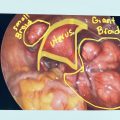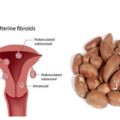A fibroid, also known as a uterine fibroid or leiomyoma, is a non-cancerous (benign) tumor that develops in or around the uterus of a woman. It is the most common type of tumor found within the female reproductive system. Fibroids are composed of smooth muscle cells and fibrous connective tissue and can vary in size, ranging from small nodules that are barely detectable to larger growths that can distort the shape of the uterus.
Fibroids can occur in different locations within the uterus, which leads to various types:
- Intramural Fibroids: These fibroids grow within the muscular wall of the uterus.
- Submucosal Fibroids: These fibroids develop just beneath the inner lining of the uterus and can extend into the uterine cavity.
- Subserosal Fibroids: These fibroids grow on the outer surface of the uterus.
- Pedunculated Fibroids: Subserosal fibroids can sometimes develop a stalk (peduncle) that allows them to hang off the uterus or other nearby organs.
Fibroids are influenced by hormones, particularly estrogen and progesterone, and their growth is often associated with reproductive age. They can cause a range of symptoms, including heavy or prolonged menstrual bleeding, pelvic pain or pressure, frequent urination, constipation, and an enlarged abdomen. However, some women with fibroids may not experience any symptoms at all.
The exact cause of fibroid development isn’t fully understood, but genetics, hormones, and growth factors are believed to play a role. While fibroids are not cancerous, their presence and associated symptoms can impact a woman’s quality of life and reproductive health. Treatment options vary based on factors such as the size, location of the fibroids, and the severity of symptoms. It’s important for individuals experiencing symptoms or suspecting they have fibroids to seek medical evaluation and guidance from a healthcare professional.
How is Fibroid Removed?
Fibroids can be removed through various medical and surgical procedures, depending on factors such as the size and location of the fibroids, the severity of symptoms, and the patient’s desire for future fertility. Here are some common methods for removing fibroids:
- Myomectomy: This surgical procedure involves the removal of fibroids while preserving the uterus. Myomectomy is an option for women who wish to retain their fertility. There are several approaches to performing a myomectomy, including:
- Abdominal myomectomy: A larger incision is made in the abdomen to access and remove fibroids.
- Laparoscopic myomectomy: Several small incisions are made, and a camera and surgical instruments are inserted to remove the fibroids.
- Hysteroscopic myomectomy: Fibroids that are within the uterine cavity can be removed using a hysteroscope inserted through the cervix and into the uterus.
- Hysterectomy: In cases where fertility is not a concern and symptoms are severe or if there are multiple or very large fibroids, a hysterectomy may be recommended. A hysterectomy involves the surgical removal of the uterus. Depending on the specific circumstances, the cervix and ovaries may also be removed.
- Uterine Artery Embolization (UAE): This is a non-surgical procedure in which the blood supply to the fibroids is blocked, causing them to shrink. It is done by injecting small particles into the arteries that supply blood to the fibroids, cutting off their blood flow.
- MRI-Guided Focused Ultrasound Surgery (MRgFUS): This non-invasive procedure uses focused ultrasound waves to heat and destroy the fibroid tissue. It is guided by real-time MRI imaging to precisely target the fibroids.
- Endometrial Ablation: This procedure destroys the lining of the uterus (endometrium) and can be used to treat small fibroids that are causing heavy menstrual bleeding.
The choice of removal method depends on individual factors and patient preferences. The recovery time and potential impact on fertility also vary among these procedures. It’s important for individuals to consult with a gynecologist or healthcare provider to discuss their options and determine the most appropriate treatment approach for their specific situation.
Will My Stomach Be Flat After Fibroid Removal?
The outcome in terms of stomach appearance after fibroid removal can vary significantly depending on factors such as the size and location of the fibroids, the surgical approach used for their removal, and your individual body composition.
While fibroids can cause an enlarged abdomen or bloating in some cases, their removal doesn’t always guarantee an immediately flat stomach. Here are a few factors to consider:
- Fibroid Size and Number: Larger fibroids or multiple fibroids can contribute to abdominal distension. Removing them can certainly help reduce the size of the uterus and abdominal area, but it might not necessarily result in a completely flat stomach.
- Surgical Approach: The method used for fibroid removal plays a role. Laparoscopic procedures (small incisions) are minimally invasive and may result in less postoperative swelling and a quicker recovery. Traditional abdominal surgeries (larger incisions) might lead to more initial swelling and a longer recovery period.
- Body Composition: Your body’s natural shape and composition also play a role in how your abdomen appears after surgery. Some people naturally have flatter stomachs due to factors such as muscle tone, body fat distribution, and genetics.
- Healing Process: After surgery, there can be some swelling and fluid retention around the incision sites or the treated area. This is a normal part of the healing process and should subside over time.
- Postoperative Care: Following your surgeon’s postoperative care instructions, including wearing any recommended compression garments and engaging in gentle movement as advised, can help manage swelling and support your recovery.
It’s important to have realistic expectations about the outcome of fibroid removal surgery. While the primary goal is to alleviate symptoms and improve your overall health, a perfectly flat stomach might not be the immediate result. If you’re concerned about how your abdomen will appear after surgery, discussing your expectations and concerns with your healthcare provider or surgeon can provide you with a clearer understanding of what to anticipate based on your specific situation.






